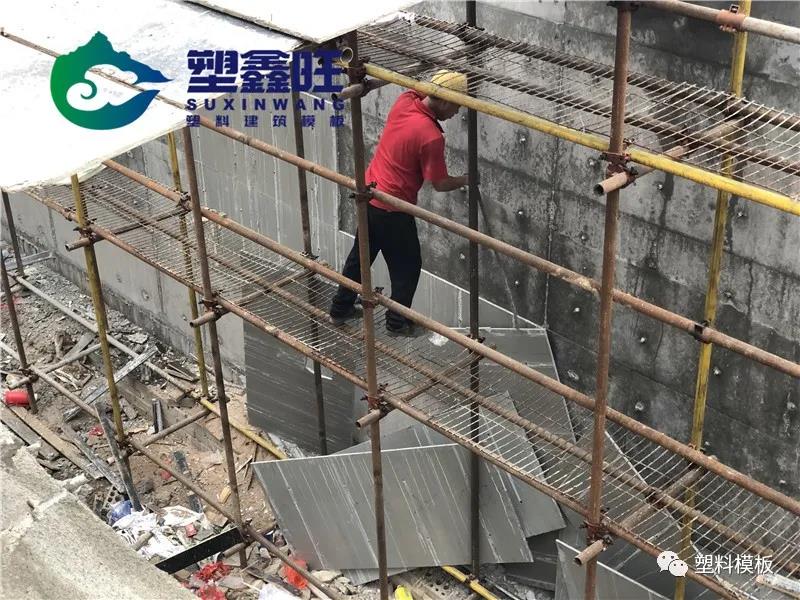
After the concrete structure is poured, the concrete hardening must reach a certain strength, and then the formwork can be removed, which is judged according to the compressive strength of the formwork removal test block under the same condition maintenance. The effect of concrete wall has a lot to do with formwork removal, because the early pouring has been finalized, and the time of formwork removal is not well grasped, or if the method of formwork removal is not good, it will not only affect the normal growth of concrete strength, but also cause damage to concrete appearance, that is, it will affect the demoulding effect. Therefore, whether it is wood formwork, steel formwork or hollow plastic formwork, formwork removal is all about ways and methods. In addition, if the formwork is removed properly, the turnover of the formwork can be greatly improved.
In order to help customers use hollow plastic building formwork correctly, improve turnover rate, reduce use cost and guarantee construction quality, engineers of Fujian Suxinwang New Energy Co., Ltd. visited a number of customer sites on the spot, found old masters who had many years of experience in demoulding, and asked them for precautions for demoulding hollow plastic formwork. Good products and correct construction can prolong the service life of formwork.
First of all, the hollow plastic formwork, like several other building formwork, must master the appropriate dismantling time to ensure the structural safety and appearance quality of concrete.
(1) when the hollow plastic formwork is removed, it must be removed from both ends of the scaffold at the same time and fall at the same time; When the template falls, it is best to keep falling horizontally, and avoid letting the corners fall vertically against the ground; Try to keep the floor clean, like some construction waste, such as nails and waste steel bars, so as to prevent the surface of the formwork from being damaged and affect the next use.
(2) The order of formwork removal is to start from a small formwork. When dismantling, dismantle the formwork while dismantling the support. In the process of formwork removal, prevent large area from falling off and prevent safety accidents.
(3) In the process of dismantling the formwork, if the adhesion between the hollow plastic formwork and the concrete is very strong, don't use too much force and rush. We can tap the outside of the formwork to make it slightly loose, and then try to dismantle the formwork.
(4) Never dismantle the formwork violently, because the hollow plastic formwork is divided into longitudinal and transverse directions, and the tearing stress between longitudinal and transverse directions is different. Because the longitudinal direction is a hollow structure, the intermolecular force is not enough to support it. If the formwork is dismantled violently along the longitudinal direction during the dismantling process, it will easily lead to the longitudinal tearing of the formwork. The correct method is to use the lifting hook to exert force along the transverse direction of the formwork, because the transverse strength is high.
(5) In addition, in the process of formwork removal, it is forbidden to hit hard and pry hard. Once the formwork is loose, gently pull the formwork with an iron hook, so that the formwork can buffer the fall as far as possible. If the formwork is too hard, the edges and corners will easily hit the ground and cause local damage (brittle crack, missing corners, round edges, etc.). In the next construction, it is easy to cause the joint between the formwork to be not tight, resulting in slurry leakage and other phenomena. Under normal circumstances, the hollow plastic formwork can be recycled for about 50 times. If the formwork is damaged locally due to improper formwork removal, the whole board cannot be recycled repeatedly, which is a pity.
(6) After the template is removed, it shall not be thrown or piled on the operation layer and scaffolding, otherwise the template will easily lead to safety problems due to improper placement or the corner will be damaged due to the second fall of the template; Remove the template, to clean up, repair clean, if the newly removed hollow plastic template has hard cement adhesion, tap the template surface, or rinse with clear water, let the cement drop; Cleaned templates shall be stacked neatly and marked for reuse.
Many people use hollow plastic templates for the first time, and workers are used to using wooden templates. At the beginning, they are really reluctant to use new things, and they will be picky. Especially, when they start to use them, they will contradict this new thing from the bottom of their hearts. Whether the hollow plastic template is applicable or not, I think we should comprehensively evaluate and consider: the hollow plastic template has been in the market for several years, after several iterations and upgrades, It is a mature product in terms of turnover times, strength and toughness, etc. Its rigidity and toughness also meet the needs of construction, and it can be recycled at a high price, recycling economy and benefiting the country and the people.

To learn more about hollow plastic template, you can pay attention to WeChat WeChat official account "Plastic Template". Fujian Suxinwang New Energy Co., Ltd. always adheres to the tenet of "quality first, honesty first, win-win cooperation and customer-centered", continuously improves products to meet customer needs, and sincerely welcomes new and old customers to visit and negotiate business! Tel: 0596-3295 888, 139 5014 2388; 400-8339-008,139 2577 5994!


